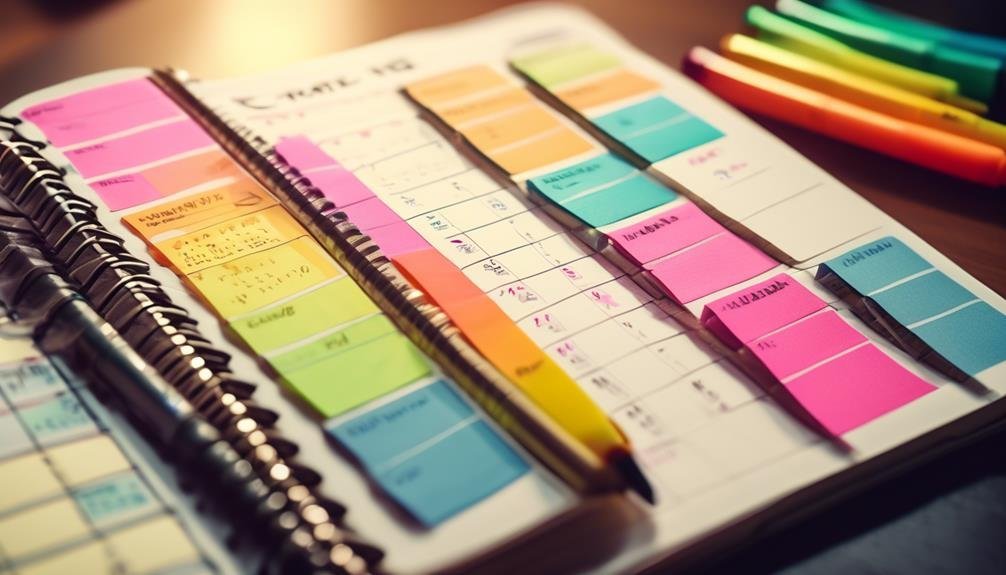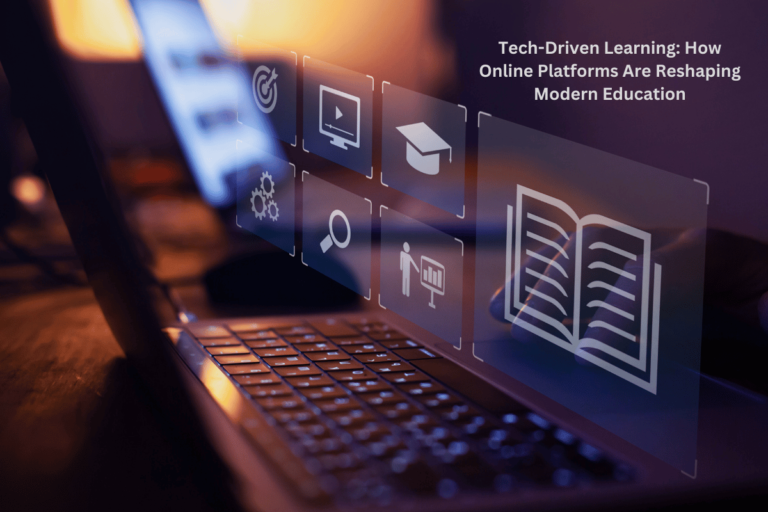How to Create a Learning Schedule That Sticks
Crafting a learning schedule that sticks is like building a sturdy bridge – it requires careful planning and a solid foundation. But it's not just about creating a schedule; it's about making it work for you in the long run.
So, how can you ensure that your learning schedule becomes a consistent and effective part of your routine? There are key strategies that can help you achieve this, and they go beyond simply penciling in study times.
Let's explore how you can set clear goals, prioritize activities, establish routines, and more to create a learning schedule that truly sticks.
Key Takeaways
- Setting clear goals and breaking them into manageable milestones is essential for creating an effective learning schedule.
- Consistency and establishing daily habits and routines are crucial for successful learning.
- Identifying optimal learning times and creating accountability measures can help improve productivity and motivation.
- Incorporating breaks and rewards, as well as embracing flexibility and adapting to change, are important factors in creating a learning schedule that sticks.
Setting Clear Goals
When creating your learning schedule, it's crucial to set clear and specific goals that are achievable within a realistic timeframe. Goal setting strategies play a pivotal role in effective time management. Start by defining your long-term learning objectives, then break them down into smaller, manageable milestones. This approach not only makes your goals less daunting but also provides a sense of achievement as you reach each milestone.
Research has shown that individuals who set specific, challenging goals coupled with regular feedback mechanisms are likely to perform better.
Achieving milestones is a great way to track your progress. As you reach each milestone, take the time to reflect on what worked well and what could be improved. This practice not only aids in measuring success but also allows for adjustments to be made to your learning schedule, ensuring continuous improvement. Utilize tools such as progress trackers or journals to monitor your advancement. Tracking progress not only provides a visual representation of your achievements but also serves as motivation to keep pushing forward.
Prioritizing Learning Activities
After setting clear and specific goals for your learning schedule, the next step is to prioritize your learning activities to ensure efficient use of your time and resources. Time management is crucial in prioritizing your learning activities.
Start by assessing the urgency and importance of each learning task. Use techniques such as the Eisenhower Matrix, which categorizes tasks into four quadrants based on urgency and importance. This allows you to identify which activities to prioritize and which to delegate or eliminate.
Additionally, consider your peak learning hours. Allocate the most challenging or important learning activities to the times when you're most alert and focused.
Learning priorities should be based on your overall goals and the specific knowledge or skills you need to achieve them. Identify the most critical areas of learning that align with your goals. Allocate sufficient time to these high-priority activities to ensure steady progress.
Remember to balance depth and breadth in your learning priorities. Focusing too narrowly on one area may limit your overall development, while spreading yourself too thin may hinder mastery of key skills.
Establishing a Routine
Now it's time to start establishing a routine for your learning schedule. Consistency is key when it comes to learning, so it's important to set daily habits that work for you.
Building study rituals can help create a sense of structure and make it easier to stick to your learning schedule.
Time for Consistency
Establishing a consistent routine is crucial for effective learning and long-term retention of information. Consistency benefits your learning process by helping your brain establish strong neural pathways, which aid in memory retention.
To achieve consistency, effective time management strategies are essential. Start by setting specific, achievable goals for your study sessions and allocate dedicated time slots each day for learning. Create a structured schedule that includes regular breaks to prevent burnout and maintain focus.
Consider your peak productivity hours and align your study sessions with those times. Additionally, eliminate distractions during your dedicated study time to maximize concentration and efficiency.
Setting Daily Habits
Creating a structured routine is key to setting daily habits that will optimize your learning potential and aid in long-term retention of information. Establishing consistency in your daily habits is crucial for effective learning.
To do this, start by setting specific times for different activities, such as studying, exercising, and leisure. Make sure to include regular breaks to avoid burnout and maintain focus.
Additionally, incorporate daily reflection into your routine. This can involve reviewing what you've learned, identifying areas for improvement, and setting goals for the next day. Research shows that reflective practices enhance learning and help solidify new information in your memory.
Building Study Rituals
To build effective study rituals, it's essential to establish a consistent routine that aligns with your learning goals and optimizes your cognitive performance. Creating a study environment that's conducive to learning is crucial. Find a quiet, well-lit space with minimal distractions. Keep your study area organized and equipped with the necessary materials to avoid interruptions.
Additionally, scheduling breaks is vital for maintaining focus and preventing burnout. Research suggests that taking short, regular breaks can help improve concentration and productivity. Consider using the Pomodoro Technique, which involves 25 minutes of focused work followed by a 5-minute break. Experiment with different break schedules to find what works best for you.
Identifying Optimal Learning Times
Identifying your optimal learning times involves observing your own energy levels and cognitive functioning throughout the day to determine when you're most alert and focused. Understanding your peak performance periods can significantly enhance the effectiveness of your learning schedule.
It's essential to align your study sessions with your natural circadian rhythm, the internal clock that regulates your sleep-wake cycle and affects various bodily functions, including cognitive performance.
Here are some practical tips to help you identify your optimal learning times:
- Keep a journal: Track your energy levels, focus, and alertness at different times of the day to identify patterns.
- Take cognitive tests: Use online tools to assess your cognitive functions at various times to pinpoint when you perform best.
- Experiment with different times: Try studying during different parts of the day to see when you feel most productive and focused.
- Pay attention to mood: Note how your mood and motivation levels change throughout the day, as this can impact your learning abilities.
- Consider personal commitments: Factor in your daily commitments and responsibilities to find time slots that align with your optimal learning times.
Creating Accountability Measures
When establishing accountability measures for your learning schedule, consider setting specific, measurable goals to track your progress and maintain motivation. Accountability partners can be incredibly beneficial in helping you stay on track. Pairing up with a friend or colleague who shares similar learning goals allows you to hold each other accountable, provide support, and celebrate achievements together.
Additionally, progress tracking is crucial for maintaining accountability. Utilize tools such as learning journals or apps to monitor your learning milestones and reflect on your progress regularly.
Self-assessment is another vital accountability measure. Set aside time for reflection and use prompts to evaluate your learning journey. Ask yourself questions such as 'What did I learn today?' or 'Did I meet my daily learning goals?' This practice promotes self-accountability and helps you identify areas for improvement.
Moreover, consider setting up regular check-ins with your accountability partner or mentor to discuss your progress and challenges. Having these discussions can provide valuable insights and support to help you stay committed to your learning schedule.
Incorporating Breaks and Rewards
Consider incorporating regular short breaks and rewards into your learning schedule to maintain focus and motivation. Incorporating mindfulness breaks can significantly enhance your learning experience. Research shows that taking short breaks to practice mindfulness or relaxation techniques can improve attention, memory, and cognitive performance. Set aside 5-10 minutes for deep breathing, meditation, or simply being present in the moment to rejuvenate your mind and prepare for the next study session.
Rewarding progress with treats can also be an effective strategy. When you accomplish a specific learning goal or complete a challenging task, treat yourself to something enjoyable. It could be a small snack, a brief walk outside, or a quick chat with a friend. These rewards can reinforce positive behavior and create a sense of accomplishment, boosting your motivation to continue learning.
Consider incorporating short physical activity breaks into your schedule. Research suggests that short bursts of physical activity can enhance cognitive function, improve mood, and boost overall productivity. Try doing some stretches, walking around, or engaging in a quick workout to re-energize your body and mind.
Incorporate breaks for social interaction. Connecting with others can provide a mental break, reduce stress, and foster a sense of belonging. Schedule short breaks to chat with a friend, family member, or colleague. It can help you recharge and maintain a healthy balance between learning and socializing.
Set up a rewarding system for achieving milestones. Break down your learning goals into smaller, manageable tasks and reward yourself after completing each one. By celebrating these small victories, you can stay motivated and sustain your learning schedule in the long run.
Embracing Flexibility
When creating a learning schedule, it's crucial to embrace flexibility and be open to adjustments.
Adapting to change is an essential skill that will allow you to navigate unexpected challenges and opportunities.
Adapting to Change
Embracing flexibility in your approach to learning allows you to adapt more readily to changes and seize new opportunities for growth and development. When it comes to adapting to change, remember that flexibility is key.
Here are some practical tips to help you embrace change and uncertainty in your learning journey:
- Embrace a growth mindset to view challenges as opportunities.
- Seek feedback and be open to making adjustments to your learning strategies.
- Prioritize self-care to maintain resilience and adaptability during transitions.
- Stay organized but be willing to adjust your schedule and plans as needed.
- Continuously seek new learning opportunities and remain open to exploring different methods or resources.
Open to Adjustments
Remaining open to adjustments is essential in embracing flexibility as you navigate your learning journey. Embracing a customizable approach allows you to tailor your learning schedule to your individual progress and learning style.
It's crucial to recognize that your learning journey is unique, and what works for others may not work for you. Therefore, staying open to adjustments enables you to create a personalized schedule that aligns with your specific needs and preferences.
Flexibility in your approach to learning empowers you to adapt your schedule as needed, ensuring that it remains effective and relevant. By remaining open to adjustments, you can continuously refine and optimize your learning schedule, ultimately enhancing your overall learning experience and outcomes.
Utilizing Technology Tools
To enhance your learning schedule, consider incorporating various technology tools that cater to your specific learning needs and preferences. Technology integration allows for personalized learning experiences, and digital tools enable self-paced learning, making it easier to stay on track with your schedule.
Here are five technology tools to consider integrating into your learning routine:
- Digital Note-Taking Apps: Use apps like Evernote or OneNote to organize your notes, create to-do lists, and set reminders for important deadlines. These apps allow you to access your notes across multiple devices, ensuring that you have all your study materials at your fingertips.
- Online Learning Platforms: Platforms such as Coursera, Khan Academy, or Udemy offer a wide range of courses and tutorials on various subjects. You can choose courses that align with your learning schedule and preferences, and many of them offer self-paced learning options.
- Time Management Apps: Utilize apps like Trello or Todoist to plan and organize your study sessions. These apps can help you break down your learning schedule into manageable tasks and track your progress.
- Virtual Study Groups: Join online study groups or use platforms like Zoom or Skype to connect with peers for collaborative learning. This allows for discussions, sharing resources, and mutual support in sticking to your learning schedule.
- Interactive Learning Resources: Explore interactive resources such as educational YouTube channels, educational podcasts, or interactive websites that offer engaging content aligned with your learning goals. These resources can make learning more enjoyable and effective, keeping you motivated to stick to your schedule.
Managing Distractions
Considering the prevalence of digital distractions in today's learning environment, effectively managing these interruptions is crucial for maintaining a productive learning schedule. Minimizing interruptions and staying focused are essential skills to develop. Here are some practical strategies to help you manage distractions and maximize your learning time:
| Time Waster | Solution |
|---|---|
| Multitasking | Focus on one task at a time to enhance productivity and learning retention. Avoiding multitasking allows you to concentrate fully on the material at hand. |
| Social Media | Use website blockers or apps to limit access to social media during study sessions. Set specific times for checking social media to avoid constant interruptions. |
| Email Notifications | Turn off email notifications or schedule specific times to check and respond to emails. This helps in maintaining focus without being constantly pulled away by incoming messages. |
Evaluating and Adjusting
When evaluating and adjusting your learning schedule, it's essential to objectively assess your progress and make necessary modifications to optimize your study habits. Here are some practical strategies to help you effectively evaluate and adjust your learning schedule:
- Track Your Progress: Use a study journal or app to keep track of your daily progress, including the topics covered, time spent, and any challenges faced.
- Seek Feedback: Discuss your learning schedule with a mentor, teacher, or study partner to gain insights and suggestions for improvement.
- Reflect on Goals: Regularly revisit your learning goals and assess whether your current schedule is helping you make progress towards achieving them.
- Adjusting Strategies: Be open to adjusting your study methods, such as trying different note-taking techniques or using alternative resources to enhance your understanding.
- Maintaining Motivation: Regularly evaluate your motivation levels and take steps to re-ignite your passion for learning, such as setting rewards for achieving milestones or finding a study buddy for mutual support.
Conclusion
In conclusion, setting clear goals, prioritizing activities, and establishing a routine are all essential steps in creating a learning schedule that sticks.
Identifying optimal times, creating accountability measures, and embracing flexibility are also important factors in maintaining a successful learning schedule.
Additionally, utilizing technology tools, managing distractions, and evaluating and adjusting the schedule as needed can greatly enhance the effectiveness of the learning process.
By following these steps, you can ensure a successful and effective learning schedule that will help you achieve your learning goals.
Remember, consistency is key, and with the right approach, you can make learning a permanent part of your routine.







